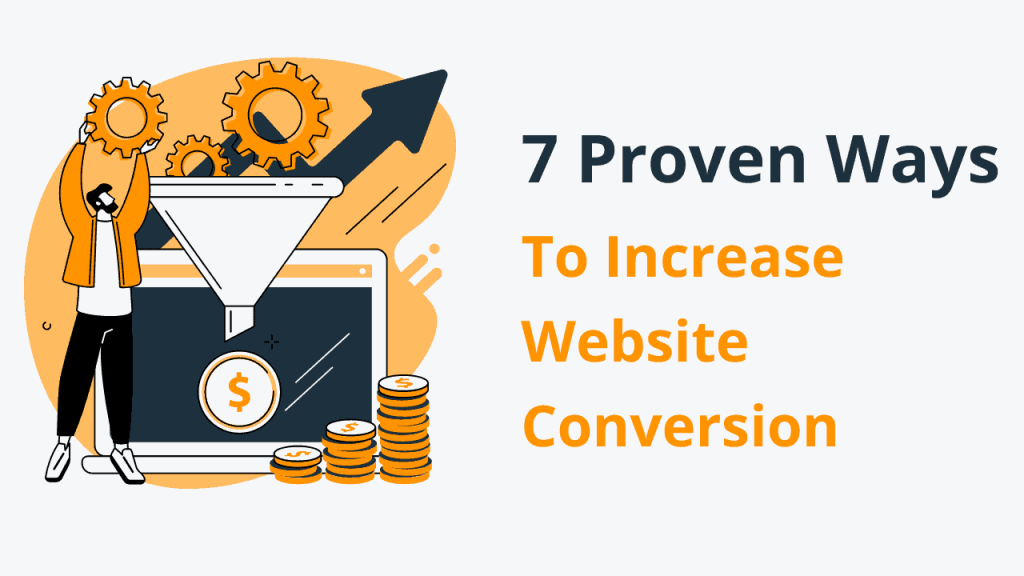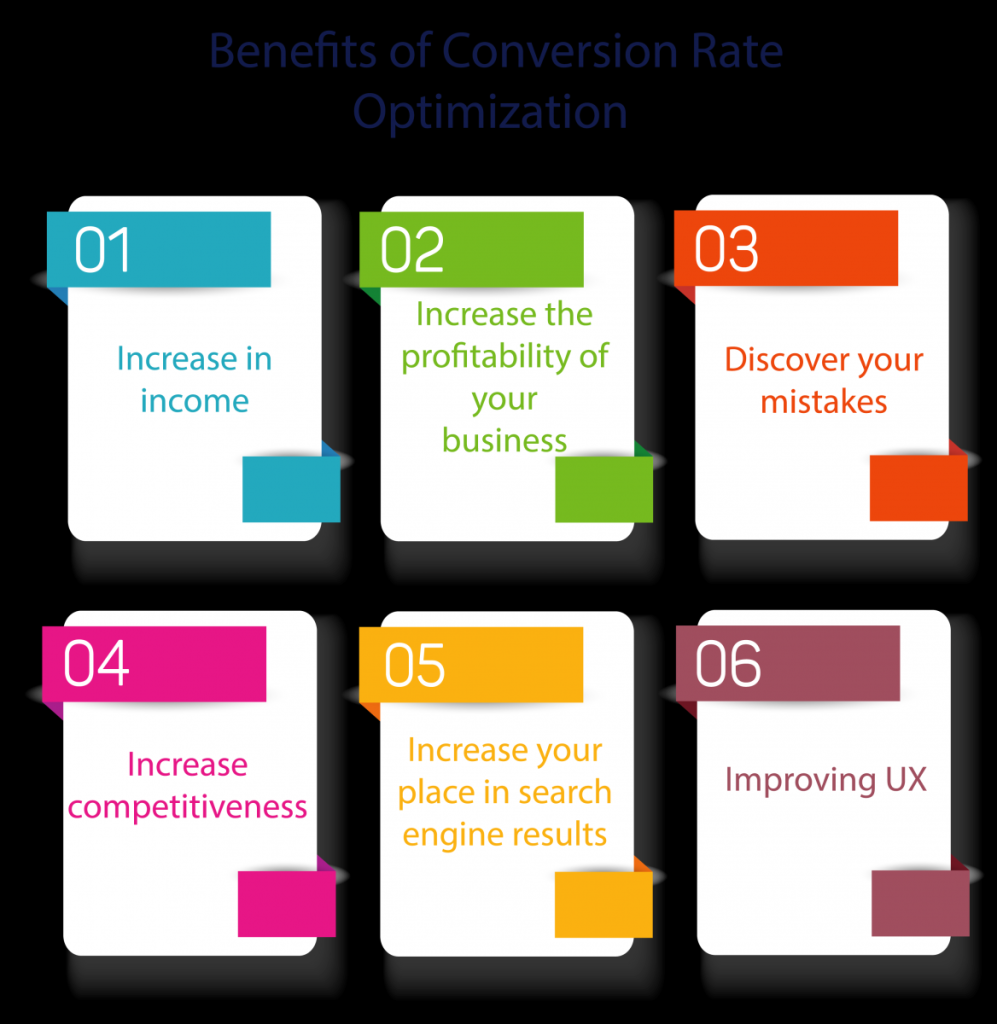What is Conversion Rate Optimization (CRO)?

Conversion Rate Optimization (CRO) is the process of optimizing a website or landing page to increase the percentage of visitors who complete a desired action or conversion. The main objective of CRO is to improve the effectiveness of a website by maximizing the number of visitors who take specific actions that align with the website’s goals, such as making a purchase, submitting a form, or subscribing to a newsletter.
The CRO process involves several steps to achieve higher conversion rates:
- Defining Goals: Clearly identifying the desired goals or conversions that the website aims to achieve, such as sales, leads, or sign-ups.
- Analyzing User Behavior: Conducting data analysis to understand user behavior and gather insights. This includes examining website traffic, click-through rates, bounce rates, and conversion funnels to identify areas of improvement and potential obstacles to conversions.
- Identifying Optimization Areas: Based on the analysis, specific areas or elements of the website that influence conversions are identified. These could include design, layout, content, forms, calls-to-action (CTAs), and the checkout process.
- Developing Hypotheses: Formulating hypotheses to address the identified areas for optimization. For example, if the checkout process is complex, a hypothesis could be to simplify it by reducing steps or providing clearer instructions.
- Conducting Experiments: Using A/B testing or multivariate testing to experiment with different variations of website elements. Different versions of a web page are presented to different segments of the audience, and their performance is measured to determine which version yields the highest conversion rate.
- Implementing Changes: Based on the experiment results, implementing changes that lead to improved conversions. This may involve modifying design, adjusting the placement of CTAs, rewriting content, or employing other optimization techniques.
- Continuous Monitoring and Optimization: CRO is an ongoing process that requires continuous monitoring of the website’s performance. Changes are tracked, data is analyzed, and the impact on conversions is measured. The optimization process is refined based on insights gained from the data.
Through CRO strategies, businesses can enhance user experience, remove barriers to conversions, and improve the overall effectiveness of their website. By maximizing the value of website traffic, increasing customer engagement, and driving more conversions, CRO helps businesses achieve their goals and boost revenue.
How do you optimize Conversion Rate Optimization (CRO)?

To optimize Conversion Rate Optimization (CRO) and improve website performance in driving conversions, follow these key steps:
- Establish Clear Goals: Clearly define specific goals or desired conversions, such as purchases, form submissions, or newsletter sign-ups.
- Analyze User Behavior: Gather and analyze data on user behavior to identify areas for improvement. Utilize tools like Google Analytics for insights on navigation patterns, pain points, and areas needing optimization.
- Conduct User Research: Perform qualitative research through surveys, interviews, or user testing to gain a deeper understanding of user preferences, motivations, and pain points.
- Enhance Website Design: Improve the overall design by creating a visually appealing, intuitive, and user-friendly interface. Streamline navigation, optimize layout, and ensure mobile responsiveness for a seamless user experience.
- Optimize Page Load Speed: Reduce page load times by minimizing image sizes, leveraging browser caching, and optimizing code. Faster load times minimize user abandonment.
- Optimize Calls-to-Action (CTAs): Create compelling, visually striking CTAs that communicate value and encourage action. Strategically place CTAs throughout the website, ensuring visibility and ease of interaction.
- Streamline Conversion Funnels: Simplify and streamline conversion processes by minimizing steps, eliminating unnecessary form fields, and providing clear instructions. Identify and address any bottlenecks in the conversion flow.
- Implement A/B Testing: Conduct A/B or multivariate testing to experiment with variations of website elements, such as headlines, CTAs, layouts, and colors. Analyze results to determine the most effective versions.
- Personalize User Experience: Utilize personalization techniques to deliver customized experiences based on user preferences, browsing history, or demographics. Provide relevant content, recommendations, or offers to enhance engagement and conversions.
- Monitor and Analyze Data: Continuously monitor website performance, conversion rates, and user behavior using analytics tools. Track key metrics and identify areas needing improvement.
- Iterate and Refine: CRO is an ongoing process. Continuously iterate and refine the website based on data analysis, user feedback, and testing. Implement changes, monitor results, and make further improvements to achieve higher conversion rates.
By following these optimization strategies and consistently refining your approach based on data and user feedback, you can effectively optimize CRO and increase website conversions.
Strategies for Increasing Website Conversions.

Here are the best Strategies for Increasing Website Conversions.
- Enhance Website Design and User Experience: Focus on optimizing your website’s layout, navigation, and design to create a seamless user experience. Prioritize a visually appealing website that loads quickly, is easy to navigate, and engages visitors to encourage conversions.
- Optimize Landing Pages: Develop targeted landing pages for different campaigns and ensure they are optimized for conversions. Craft compelling headlines, utilize clear call-to-action buttons, and create persuasive copy that guides visitors toward taking the desired action.
- Conduct A/B Testing: Utilize A/B testing to compare various versions of web pages, including different elements such as headlines, layouts, colors, call-to-action buttons, and more. Analyze the results to identify high-performing elements and continuously refine your website for better conversion rates.
- Improve Call-to-Action (CTA) Placement and Design: Strategically place CTAs on your website to make them visually prominent. Use action-oriented language, consider contrasting colors, and ensure CTAs are easily clickable across all devices.
- Highlight Irresistible Value Propositions: Clearly communicate the unique benefits and value your products or services offer to visitors. Showcase key features, advantages, and any distinct selling points that differentiate your brand from competitors.
- Leverage Social Proof: Incorporate social proof elements such as customer testimonials, reviews, case studies, and trust symbols to establish credibility and build trust with your audience. Positive social proof can alleviate doubts and motivate visitors to convert.
- Streamline the Conversion Process: Minimize the steps and form fields required for visitors to complete a conversion. Simplify the checkout process for e-commerce websites, reduce form complexity, and provide guest checkout options to minimize friction.
- Implement Exit Intent Pop-ups: Utilize exit intent technology to display targeted pop-ups or offers when visitors are about to leave your website. These pop-ups can present discounts, incentives, or additional information to entice visitors to reconsider and convert.
- Utilize Retargeting and Remarketing: Implement retargeting and remarketing campaigns to reconnect with users who have previously visited your website but did not convert. Display personalized ads or offers to re-engage them and increase the chances of conversion.
- Embrace Personalization: Utilize data and segmentation to personalize the user experience on your website. Tailor content, recommendations, and offers based on user preferences, behavior, and demographics to deliver a more relevant and engaging experience.
What are the benefits of Conversion Rate Optimization (CRO)?

Conversion Rate Optimization (CRO) offers several benefits for businesses aiming to improve their website performance and drive better results.
Here are some key benefits of implementing CRO:
- Increased Conversions: One of the primary benefits of implementing CRO is achieving higher conversion rates. By optimizing various elements of your website, user experience, and persuasive techniques, you can encourage more visitors to take desired actions, such as making a purchase, submitting a form, or subscribing to a newsletter.
- Improved Return on Investment (ROI): CRO focuses on maximizing the value of your existing traffic rather than solely relying on driving more traffic to your website. By improving conversion rates, you can generate more revenue or achieve your goals with the same or even lower acquisition costs, leading to a higher ROI.
- Enhanced User Experience: CRO involves analyzing user behavior, preferences, and pain points. By gaining a deeper understanding of your visitors’ needs and optimizing their journey, you can create a better user experience. This results in increased satisfaction, higher engagement, and improved customer loyalty.
- Valuable Customer Insights: Through CRO, you gain valuable insights into your customers’ behavior and preferences. By analyzing data from A/B tests, user feedback, and other optimization techniques, you can better understand your audience. These insights can inform future marketing efforts and overall business strategies.
- Competitive Advantage: Implementing CRO allows you to differentiate your brand from competitors. By continuously refining your website, testing new strategies, and delivering a superior user experience, you can gain a competitive edge. This leads to increased customer trust, loyalty, and market differentiation.
- Cost Savings: CRO can lead to cost savings by optimizing your marketing spend. Instead of investing more in advertising and acquisition, improving conversion rates allows you to maximize the value of your existing traffic and resources. This can reduce customer acquisition costs and improve overall efficiency.
- Data-Driven Decision Making: CRO relies on data analysis, testing, and experimentation. By adopting a data-driven approach, you can make informed decisions based on real insights rather than assumptions or guesswork. This results in more effective marketing strategies and better resource allocation.
- Continuous Improvement: CRO fosters a culture of continuous improvement within your organization. By regularly testing and optimizing your website, you can identify areas for enhancement, discover new opportunities, and adapt to changing market dynamics. This iterative approach ensures that your website remains effective and competitive in the long run.
By leveraging the benefits of CRO, businesses can achieve higher conversion rates, improved user experiences, and ultimately drive better results, leading to business growth and success.
Success in Conversion Rate Optimization (CRO)?

Success in Conversion Rate Optimization (CRO) is achieved through a combination of strategic planning, data analysis, experimentation, and continuous improvement.
Here are some key factors that contribute to success in CRO:
- Clear Objectives: Clearly define your conversion goals and objectives. Establish specific targets, such as increasing sales, generating leads, or boosting email sign-ups. Well-defined goals provide direction for your optimization efforts.
- Data Analysis: Analyze your website’s performance, user behavior, and conversion funnel using relevant data. Utilize analytics tools to gain insights into visitor demographics, traffic sources, user flow, and conversion rates. Identify areas for improvement and determine where potential conversions are being lost.
- User Research: Understand your target audience through user research. Conduct surveys, interviews, and usability tests to gain insights into their needs, pain points, and motivations. This qualitative data informs optimization strategies and helps tailor the user experience to their preferences.
- Conversion Funnel Analysis: Analyze your conversion funnel to identify bottlenecks and drop-off points. Optimize each stage of the funnel to reduce friction and improve the overall conversion rate.
- Hypothesis Development: Formulate data-driven hypotheses to optimize specific elements of your website, such as headlines, call-to-action buttons, forms, or page layout. Prioritize changes that are likely to have a significant impact on conversion rates.
- A/B Testing: Implement A/B testing to compare different versions of website elements. Simultaneously test variations to understand which performs better. Test one element at a time, measure results, and iterate based on insights gained.
- Personalization: Utilize personalization techniques to deliver tailored experiences to user segments. Customize content, offers, and recommendations based on user preferences, behavior, and demographics. Personalization enhances relevance and increases conversion likelihood.
- User Experience Optimization: Improve the overall user experience (UX) on your website. Ensure it is intuitive, easy to navigate, and visually appealing. Optimize page load times, streamline the checkout process, and make the conversion journey smooth.
- Continuous Iteration: CRO is an iterative process. Implement changes based on data and test results, measure impact, and iterate further. Continuously monitor optimization performance and adapt strategies as needed.
- Collaboration and Expertise: Involve cross-functional teams, such as marketing, design, development, and analytics, in your CRO efforts. Collaborate with CRO experts or consider partnering with specialized agencies to leverage their expertise and experience.
Remember, achieving success in CRO takes time and requires ongoing optimization efforts. By following these principles and continuously refining your website, you can improve conversion rates, enhance user experiences, and drive better results for your business.
Conversion Rate Optimization (CRO) Tools name.

- Google Optimize: Google Optimize is a free tool provided by Google that enables A/B testing and personalization on your website. It integrates seamlessly with Google Analytics, allowing you to analyze test results and make data-driven decisions.
- Optimizely: Optimizely is a popular experimentation platform that offers A/B testing, multivariate testing, and personalization capabilities. With its user-friendly interface and robust analytics, Optimizely empowers businesses to optimize their websites for better conversions.
- VWO: VWO (Visual Website Optimizer) is a comprehensive CRO tool that provides A/B testing, heatmaps, visitor recordings, and personalization features. It offers an intuitive visual editor and powerful analytics to help you optimize your website and improve conversion rates.
- Crazy Egg: Crazy Egg offers valuable insights into user behavior through features such as heatmaps, scroll maps, and user session recordings. By visualizing user interactions, Crazy Egg helps identify optimization opportunities to increase conversions.
- Hotjar: Hotjar combines multiple features like heatmaps, session recordings, and user feedback polls to understand user behavior on your website. It provides visual data to uncover user engagement and conversion obstacles, aiding in optimization efforts.
- Kissmetrics: Kissmetrics is a behavioral analytics tool that focuses on tracking and analyzing user interactions throughout their customer journey. By providing insights into user behavior, segmentation, and conversion funnels, Kissmetrics helps optimize conversions.
- Lucky Orange: Lucky Orange offers real-time analytics, heatmaps, visitor recordings, and conversion funnels to gain insights into user behavior. It helps identify areas of improvement and optimize conversions by making data-driven decisions.
When selecting a CRO tool, consider your specific requirements, budget, and desired features to choose the one that best fits your needs. Remember to explore each tool’s pricing plans and capabilities to make an informed decision for your business.
Thanks,






Leave a Reply
You must be logged in to post a comment.